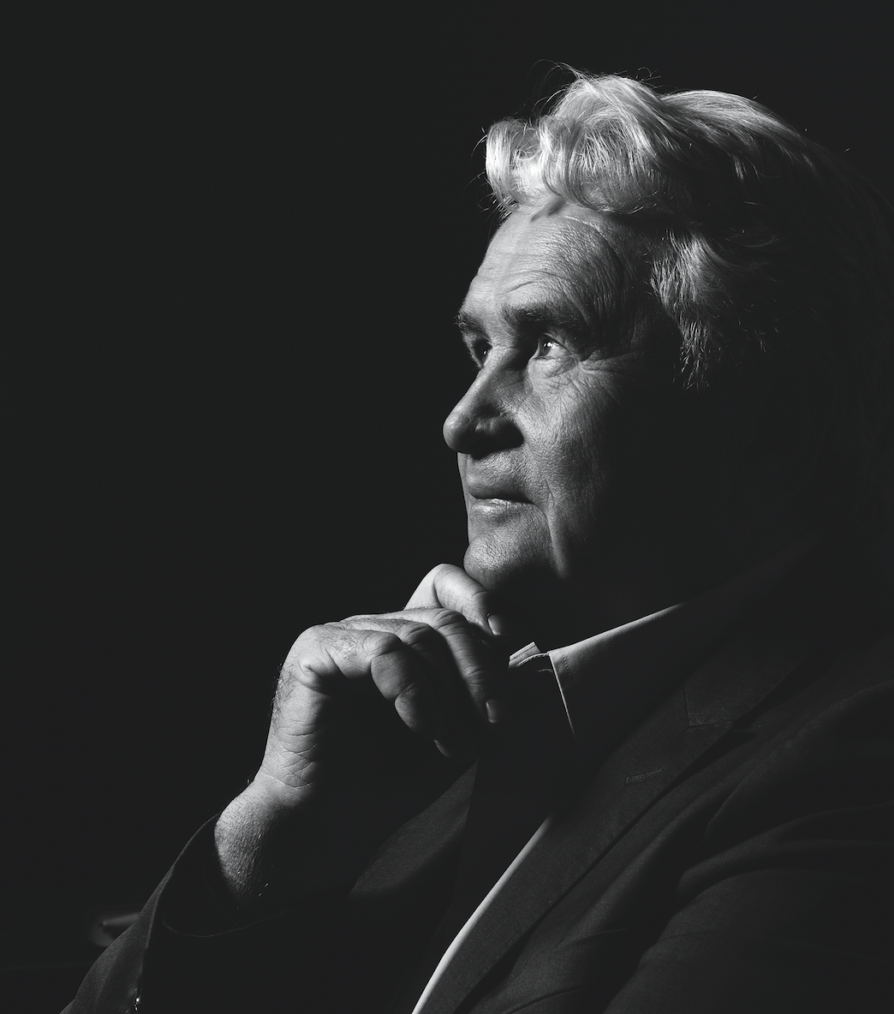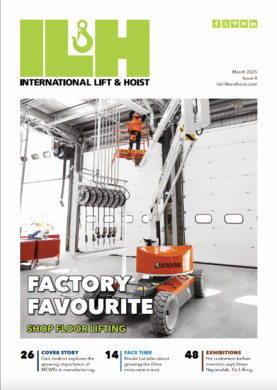)
Leading the transformation
When most people would be contemplating retirement, the energetic Ricardo Magni founded a new company. He talks to Dan Jenkins about telehandler innovation and how Magni stays one step ahead of the competition.
In religion and literature death and birth are intertwined. It was this way for Ricardo Magni, founder in 2013 of telehandler manufacturer Magni TH, a company which has grown from astart-up to more than €500m revenues in a decade.
When his father died in 1981, he stepped in to run the family company – his father designed and manufactured hydraulic and rough terrain cranes. But it was his father’s last invention which ended up shaping Ricardo’s career.
“In 1980 my father made our first telescopic handler,” says Ricardo. “He had a request from a very important construction company in Modena who needed this type of machine, so he initially made four prototypes.
“When I took over the company after he died, I was not really interested in the cranes – instead, I was fascinated by the telehandler concept. I completely redesigned the machine and showed it at the Samoter trade fair in October 1982.”
One of the visitors to his stand at Samoter was Marcel Braud, the founder of Manitou. Marcel was also no stranger to innovation, having developed the first rough terrain forklift at the end of the 1950s. “He was very interested in my machine because he realised it aligned almost 100% with the requirements of the American market.”
The companies reached an agreement, with Manitou selling Ricardo’s telehandler in North America. “The first machine had a 9000lb capacity, so around 4t, and a lifting height of 34ft or 10.5m – this was standard in the US at the time.”
Initially Ricardo had an OEM agreement to produce telehandlers for Manitou, but in 1985 the French company purchased 51% Ricardo’s family business. He continued to develop new fixed boom telehandlers, but more innovation would follow.
In 1992, after two years of development, he launched the first rotating telehandler, which was branded as the Manitou MRT 1540. It was followed by the MVT 1540, with MVT standing for Manitou Visibilité Totale. “This was the first telescopic handler with 360deg visibility,” says Ricardo. “It was the first to rotate the engine 90deg on the chassis, which created more space between the cab and the chassis and enabled us to further lower the boom position.”
At the time, Manitou decided not to pursue the MVT, but Ricardo realised that it had huge potential. “I was convinced that the rotating telehandler with the improved visibility represented a great opportunity in the market,” he says. “So, I created a company to manufacture them here in Italy, with a range from 3t and 4m to 4t and 13m. This technology is still used by almost every manufacturer in Europe today.”
A fresh start
Despite rising to become president and CEO of Manitou Italia, Ricardo’s desire grew to be the master of his own destiny once again, and in 2009 he left the French manufacturer. However, for three years he could not be active in the telehandler market due to the terms of his contract.
At the age of 60, after a highly successful career and no prospects of returning to the telehandler business for three years, he could have retired. But instead, he decided to launch Magni TH in 2013, with his children Carlo, Eugenio, Carlotta, and Chiara. “At 60 years old I started my new life,” he says. “I started with nothing apart from a lot of goodwill, a lot of positivity and perhaps a lot of craziness!” he jokes.
“I was the president of a company with 350 employees and €250m annual revenues. When I left to start Magni TH it was just me, all alone. I hired five people and an office and for three years we focused on developing the machine. Three of those people were from outside the industry and that helped us to think differently about telehandler design.
“I knew I had to make a new generation of machines, so I put the past to one side and started from a blank white sheet of paper. We wanted to make something that was, at the time, completely new.
“My strategy was to start with the bigger machines that my competitors were not able to produce at that time. In fact, we still have the highest telescopic handler in the market. From these beginnings we created the full range. Today we have machines up to 51m and with 5t to 13t lifting capacity.
“The winning feature from the beginning was the cab and the control interface with the driver. We installed a touch screen and computer which worked similarly to a tablet, using graphical representations of all the functions. You can sit in the machine and within half an hour you can understand how to operate it. That is excellent for rental fleets, and this is really what is enabling us to grow.”
The company has grown at an impressive rate. “In 2013 we started with zero turnover and last year we made €509 million.”
Achieving high growth while maintaining profitability is no mean feat. “Managing costs is a challenge for any manufacturer,” he says. “From the beginning we had to have a strong focus on managing costs. And I am proud to say that we have never increased the price of a machine after we take the order. Not even by a single Euro. That is not the norm for our industry, we have heard of competitors increasing the price by 20 or even 25 percent. We always keep our word and stick to the agreement we signed.”
The company has expanded globally and now has eight subsidiaries – one in the USA, along with Germany, Sweden, Poland, France, Belgium, the UK and South Africa. It also has 195 dealers across the world.
In total, Magni employs more than 660 people. The main production facility is nestled in Castelfranco Emilia between Modena and Bologna in what is known as Motor Valley, as it is home to Ferrari and Lamborghini as well. “We produce around 3000 machines per year and more than 90% is exported. We have a strong market in Germany and also in Italy as well as in Australia.”
Its most important market remains the USA. “Our main market is North America. In the USA I started by finding two very good salesmen and with them we focused on New York, getting the unions on side, and that led to very fast growth.
“It was really about finding the right people in America. Now we have a good situation in the USA; we have a subsidiary in New Jersey and also a logistics facility in Houston. Houston is an Atlantic port so we don’t have to go through the Panama Canal and can still deliver to either coast because it is quite central.”
The Houston site is 20,000sqm in total, including 4000sqm of buildings – offering plenty of room to expand.
Continued investment
Another key to Magni’s recent rapid growth was that it identified a huge but risky opportunity during the Covid era. “We understood in 2020 that the market would rebound the next year, very quickly,” says Ricardo. “So, we ordered sufficient components to double our production output in 2021. We went from €148m to €295m revenues, so more than double, and our lead times never went much above four to six months to deliver a machine.
“We realised the market was going to grow very fast after the worst of Covid. Our competitors were cutting their workforces and reducing their stocks, so instead we ordered double the parts and doubled our revenues as a result. In fact, we tripled revenue in less than three years.”
In 2020 the company made €148m, which it doubled in 2022. By 2023 revenue had risen to €509m. “We reacted much quicker than our competitors and that meant they could not deliver a lot of machines in 2022. By the time they had returned to higher production levels in 2023, nobody wanted the machines anymore, the market was already saturated.”
With perfect timing, Magni’s new factory also came on stream in 2021. The company had invested €10m in buying land and developing a new facility.
“Without the new factory, our investment in those extra components would have been wasted,” he says. “It was a big investment in a new facility and in our supply chain. But it made a huge difference – during this time a lot of our competitors had a red balance sheet, they lost millions of Euros at a time when we were making a good profit”.
The factory is also a strategic investment in localising Magni’s supply chain. “This is a key part of our strategy to manufacture locally as many components as possible. We don’t want suppliers based far away from us. We want to concentrate the production of all the components, to eliminate transportation pollution and costs.
“For example, we have a supplier who welds the boom sections, but in the future, we will do this ourselves. We also have a project to bring our cab supplier much closer to our facility. You ship a lot of air when you transport cabs, so we want to bring them and our cylinder manufacturer to us. In order to do this, you have to have the space to bring it all together and in Italy this is very difficult.”
Finding the space to expand was not easy, as it required the local authorities to agree that the land could change designation from agricultural to industrial. By way of thanks, Magni has made significant investments in the local community, particularly in the nearby town of Castelfranco Emilia.
“Transforming the designation of the land from agricultural to industrial significantly increases the value of the land,” he says. “However, they sold it to us at a good price, not the full price they could have asked for. We wanted to do something in return for the local community, so we built an elementary school to compensate them.”
Magni is expanding again and the total land now covers 800,000sq m, meaning more gifts to Castelfranco Emilia. “We already invested more than €2m in the school. This year and next we will also create a sports centre for the town along with a kindergarten and also 100 houses. These are our gifts to the community to thank them for their support.
“For us, this is a way to compensate the town and the region and thank them for being a part of our success. With the transfer of this land from agricultural to industrial use, they are making our future possible.”
Looking forward
While Magni TH has accelerated its growth by reacting quickly to changing market conditions, Ricardo says it is impossible to predict what is around the corner. “If I could answer this question, I would be so rich that I wouldn’t have to work anymore!” he jokes.
“In 1980, the European market for telehandlers was very small – close to zero. In almost every year of my professional life ever since, the market has grown. Last year the total world market was estimated at 88,000 units, and the forecast is that it will go to 100,000 units or more. So, this market is destined to grow.
“This year is a little bit flat because of factors like high interest rates and increased costs of raw materials and components. So, 2024 is not a year for us to increase our revenues, but the second half of next year and into 2026 will be periods in which the market will increase again, for sure.”
What continues to drive him is his passion for the sector. “I started in this industry when I was just 28 years old. Today I am 71 and I am still fully involved, because I love this business.”
He also remains ambitious and goal-oriented. “Our plan is to be number one in North America. We made a miracle I think when we started in 2015 and today we have two facilities and 52 employees. This year we will sell a lot of machines, including fixed boom telehandlers, which is new. No one has been able to sell a European-style machine in America, but we won the argument on safety. And nobody is able to offer what we offer.
“With an American machine you need a very skilled worker to operate the machine without risking to tipping it over. The operator has to understand the angle and weight, and the length of the boom and calculate all this in order to understand how to safely move the load. It is impossible, even for a skilled engineer.
“We made this argument to United Rentals and they are now a very good customer – we supplied them with 500 machines in just one order. This was for 19m fixed telehandlers with 10,000lb and 12,000lb capacities – a big change and one I never saw before in my life.
“With the RTH 8.46 we can replace a rough terrain crane with 45t capacity and also replace a telescopic boom. So, the rental company can rent out the telehandler as a replacement for the crane and also instead of an aerial work platform. We have some success this way in America where companies who used to rent or buy cranes are now replacing them with our machines. They recognise that this gives them more versatility and that brings more possibilities.
“This is the way to expand our market, by reducing demand for cranes below 35t. Now we want to go bigger. This is how I have worked all my life to introduce new products. You look at the market, propose a new solution and see if the market accepts.”











